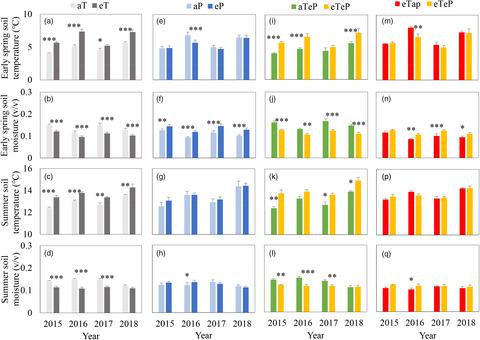Our official English website, www.x-mol.net, welcomes your
feedback! (Note: you will need to create a separate account there.)
Phenological changes offset the warming effects on biomass production in an alpine meadow on the Qinghai–Tibetan Plateau
Journal of Ecology ( IF 5.3 ) Pub Date : 2020-10-23 , DOI: 10.1111/1365-2745.13531 Hasbagan Ganjurjav 1 , Elise Gornish 2 , Guozheng Hu 1 , Jianshuang Wu 1 , Yunfan Wan 1 , Yue Li 1 , Qingzhu Gao 1
中文翻译:

物候变化抵消了青藏高原高寒草甸变暖对生物量生产的影响
更新日期:2020-10-23
Journal of Ecology ( IF 5.3 ) Pub Date : 2020-10-23 , DOI: 10.1111/1365-2745.13531 Hasbagan Ganjurjav 1 , Elise Gornish 2 , Guozheng Hu 1 , Jianshuang Wu 1 , Yunfan Wan 1 , Yue Li 1 , Qingzhu Gao 1
Affiliation

|
- Phenology is an important indicator of plant responses to environmental changes and is closely correlated with biomass production. However, how changes in phenological events affect plant biomass production when exposed to changing temperature and precipitation remain unclear.
- We conducted a 4‐year manipulative experiment of warming and precipitation addition to explore phenology–biomass interactions under climate change in a dry alpine meadow on the central Qinghai–Tibetan Plateau from 2015 to 2018.
- In dry and warm years, warming delayed phenology and precipitation addition advanced them. Warming decreased the biomass of Kobresia pygmaea in 2018 and the biomass of Poa pratensis in 2015, 2017 and 2018. However, precipitation addition significantly increased the biomass of Poa pratensis and Potentilla multifida in most of the experimental years. Phenological changes regulated the responses of biomass to treatments. Specifically, delay of green up of P. pratensis and delay of withering of K. pygmaea induced by warming can increase biomass production, but it can be offset by the direct negative effects of warming on biomass.
- Synthesis. Here we show how warming‐induced drought tend to decrease the biomass production of graminoids and the negative effects of warming on the biomass of P. pratensis and K. pygmaea were partially offset by green up postponement and withering postponement respectively. Our results highlights phenology is a crucial regulator for biomass production under climate change. Hence, both direct and indirect effects of warming and precipitation addition on phenology and biomass cannot be ignored when predicting biomass responses to climate change.
中文翻译:

物候变化抵消了青藏高原高寒草甸变暖对生物量生产的影响
- 物候学是植物对环境变化的反应的重要指标,并且与生物量的产生密切相关。但是,尚不清楚当暴露于变化的温度和降水时,物候事件的变化如何影响植物生物量的产生。
- 我们进行了一项为期四年的操纵性实验,研究了增温和增加降水量,以探索2015年至2018年青藏高原中部干旱高山草甸气候变化下物候-生物量之间的相互作用。
- 在干燥和温暖的年份,变暖延迟了物候和降水的增加。气候变暖使小嵩草的生物量在2018年减少,而在2015、2017和2018年减少了草地早熟禾的生物量。但是,在大多数实验年中,添加降水显着增加了草地早熟禾和复叶委陵菜的生物量。物候变化调节了生物量对处理的响应。具体地,绿色延迟草地早熟禾和枯萎的延迟K.矮升温可以提高的生物量产生诱导,但它可以通过加热对生物质的直接负面影响所抵消。
- 综合。在这里,我们证明了变暖导致的干旱如何降低类线虫的生物量产量,变暖对P. pratensis和K. pygmaea的负面影响分别被绿化推迟和枯萎推迟部分抵消。我们的结果表明,物候学是气候变化下生物质生产的关键调控因素。因此,在预测生物量对气候变化的响应时,不能忽略变暖和降水增加对物候和生物量的直接和间接影响。











































 京公网安备 11010802027423号
京公网安备 11010802027423号